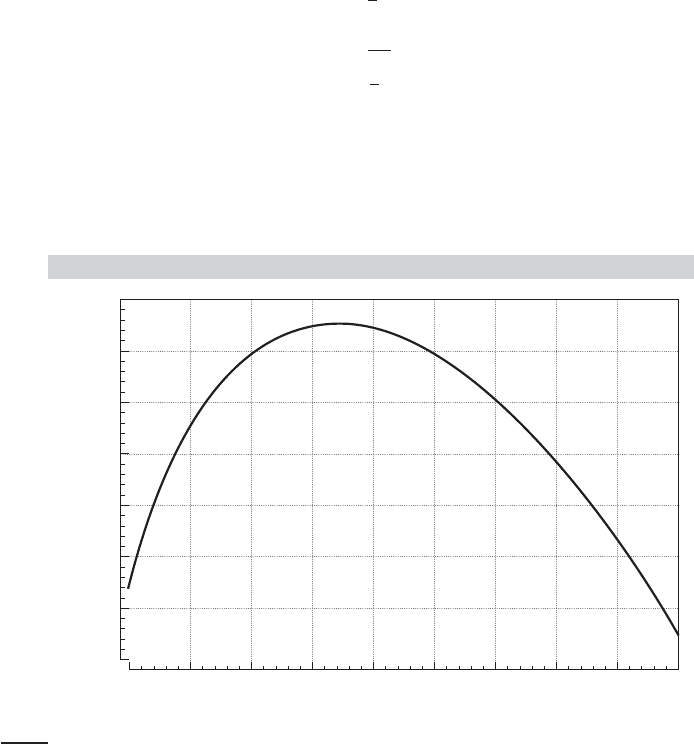Greene W.H. Econometric Analysis
Подождите немного. Документ загружается.


APPENDIX E
✦
Computation and Optimization
1099
where α is a positive number chosen large enough to ensure the negative definiteness of H
α
.
Another suggestion is that of Greenstadt (1967), which uses, at every iteration,
H
π
=−
n
i=1
|π
i
|c
i
c
i
, (E-20)
where π
i
is the ith characteristic root of H and c
i
is its associated characteristic vector. Other
proposals have been made to ensure the negative definiteness of the required matrix at each
iteration.
16
Quasi-Newton Methods: Davidon–Fletcher–Powell A very effective class of algorithms
has been developed that eliminates second derivatives altogether and has excellent convergence
properties, even for ill-behaved problems. These are the quasi-Newton methods, which form
W
t+1
= W
t
+ E
t
,
where E
t
is a positive definite matrix.
17
As long as W
0
is positive definite—I is commonly used—
W
t
will be positive definite at every iteration. In the Davidon–Fletcher–Powell (DFP) method,
after a sufficient number of iterations, W
t+1
will be an approximation to −H
−1
. Let
δ
t
= λ
t
t
, and γ
t
= g(θ
t+1
) − g(θ
t
). (E-21)
The DFP variable metric algorithm uses
W
t+1
= W
t
+
δ
t
δ
t
δ
t
γ
t
+
W
t
γ
t
γ
t
W
t
γ
t
W
t
γ
t
. (E-22)
Notice that in the DFP algorithm, the change in the first derivative vector is used in W; an estimate
of the inverse of the second derivatives matrix is being accumulated.
The variable metric algorithms are those that update W at each iteration while preserving
its definiteness. For the DFP method, the accumulation of W
t+1
is of the form
W
t+1
= W
t
+ aa
+ bb
= W
t
+ [ab][ab]
.
The two-column matrix [ab] will have rank two; hence, DFP is called a rank two update or
rank two correction. The Broyden–Fletcher–Goldfarb–Shanno (BFGS) method is a rank three
correction that subtracts vdd
from the DFP update, where v = (γ
t
W
t
γ
t
) and
d
t
=
1
δ
t
γ
t
δ
t
−
1
γ
t
W
t
γ
t
W
t
γ
t
.
There is some evidence that this method is more efficient than DFP. Other methods, such as
Broyden’s method, involve a rank one correction instead. Any method that is of the form
W
t+1
= W
t
+ QQ
will preserve the definiteness of W regardless of the number of columns in Q.
The DFP and BFGS algorithms are extremely effective and are among the most widely used
of the gradient methods. An important practical consideration to keep in mind is that although
W
t
accumulates an estimate of the negative inverse of the second derivatives matrix for both
algorithms, in maximum likelihood problems it rarely converges to a very good estimate of the
covariance matrix of the estimator and should generally not be used as one.
16
See, for example, Goldfeld and Quandt (1971).
17
See Fletcher (1980).

1100
PART VI
✦
Appendices
E.3.4 ASPECTS OF MAXIMUM LIKELIHOOD ESTIMATION
Newton’s method is often used for maximum likelihood problems. For solving a maximum like-
lihood problem, the method of scoring replaces H with
¯
H = E[H(θ )], (E-23)
which will be recognized as the asymptotic covariance of the maximum likelihood estimator. There
is some evidence that where it can be used, this method performs better than Newton’s method.
The exact form of the expectation of the Hessian of the log likelihood is rarely known, however.
18
Newton’s method, which uses actual instead of expected second derivatives, is generally used
instead.
One-Step Estimation A convenient variant of Newton’s method is the one-step maximum
likelihood estimator. It has been shown that if θ
0
is any consistent initial estimator of θ and H
∗
is
H,
¯
H, or any other asymptotically equivalent estimator of Var[g(
ˆ
θ
MLE
)], then
θ
1
= θ
0
− (H
∗
)
−1
g
0
(E-24)
is an estimator of θ that has the same asymptotic properties as the maximum likelihood estima-
tor.
19
(Note that it is not the maximum likelihood estimator. As such, for example, it should not
be used as the basis for likelihood ratio tests.)
Covariance Matrix Estimation In computing maximum likelihood estimators, a commonly
used method of estimating H simultaneously simplifies the calculation of W and solves the
occasional problem of indefiniteness of the Hessian. The method of Berndt et al. (1974) replaces
W with
ˆ
W =
n
i=1
g
i
g
i
−1
= (G
G)
−1
, (E-25)
where
g
i
=
∂ ln f (y
i
|x
i
, θ)
∂θ
. (E-26)
Then, G is the n×K matrix with ith row equal to g
i
. Although
ˆ
W and other suggested estimators of
(−H)
−1
are asymptotically equivalent,
ˆ
W has the additional virtues that it is always nonnegative
definite, and it is only necessary to differentiate the log-likelihood once to compute it.
The Lagrange Multiplier Statistic The use of
ˆ
W as an estimator of (−H)
−1
brings another
intriguing convenience in maximum likelihood estimation. When testing restrictions on parame-
ters estimated by maximum likelihood, one approach is to use the Lagrange multiplier statistic.
We will examine this test at length at various points in this book, so we need only sketch it briefly
here. The logic of the LM test is as follows. The gradient g(θ ) of the log-likelihood function equals
0 at the unrestricted maximum likelihood estimators (that is, at least to within the precision of
the computer program in use). If
ˆ
θ
r
is an MLE that is computed subject to some restrictions on θ,
then we know that g(
ˆ
θ
r
) = 0. The LM test is used to test whether, at
ˆ
θ
r
, g
r
is significantly different
from 0 or whether the deviation of g
r
from 0 can be viewed as sampling variation. The covariance
matrix of the gradient of the log-likelihood is −H, so the Wald statistic for testing this hypothesis
is W = g
(−H)
−1
g. Now, suppose that we use
ˆ
W to estimate −H
−1
. Let G be the n × K matrix
with ith row equal to g
i
, and let i denote an n × 1 column of ones. Then the LM statistic can be
18
Amemiya (1981) provides a number of examples.
19
See, for example, Rao (1973).

APPENDIX E
✦
Computation and Optimization
1101
computed as
LM = i
G(G
G)
−1
G
i.
Because i
i = n,
LM = n[i
G(G
G)
−1
G
i/n] = nR
2
i
,
where R
2
i
is the uncentered R
2
in a regression of a column of ones on the derivatives of the
log-likelihood function.
The Concentrated Log-Likelihood Many problems in maximum likelihood estimation
can be formulated in terms of a partitioning of the parameter vector θ = [θ
1
, θ
2
] such that at the
solution to the optimization problem, θ
2,ML
, can be written as an explicit function of θ
1,ML
. When
the solution to the likelihood equation for θ
2
produces
θ
2,ML
= t(θ
1,ML
),
then, if it is convenient, we may “concentrate” the log-likelihood function by writing
F
∗
(θ
1
, θ
2
) = F [θ
1
, t(θ
1
)] = F
c
(θ
1
).
The unrestricted solution to the problem Max
θ
1
F
c
(θ
1
) provides the full solution to the optimiza-
tion problem. Once the optimizing value of θ
1
is obtained, the optimizing value of θ
2
is simply
t(
ˆ
θ
1,ML
). Note that F
∗
(θ
1
, θ
2
) is a subset of the set of values of the log-likelihood function, namely
those values at which the second parameter vector satisfies the first-order conditions.
20
E.3.5 OPTIMIZATION WITH CONSTRAINTS
Occasionally, some of or all the parameters of a model are constrained, for example, to be positive
in the case of a variance or to be in a certain range, such as a correlation coefficient. Optimization
subject to constraints is often yet another art form. The elaborate literature on the general
problem provides some guidance—see, for example, Appendix B in Judge et al. (1985)—but
applications still, as often as not, require some creativity on the part of the analyst. In this section,
we will examine a few of the most common forms of constrained optimization as they arise in
econometrics.
Parametric constraints typically come in two forms, which may occur simultaneously in a
problem. Equality constraints can be written c(θ ) = 0, where c
j
(θ) is a continuous and dif-
ferentiable function. Typical applications include linear constraints on slope vectors, such as a
requirement that a set of elasticities in a log-linear model add to one; exclusion restrictions, which
are often cast in the form of interesting hypotheses about whether or not a variable should appear
in a model (i.e., whether a coefficient is zero or not); and equality restrictions, such as the sym-
metry restrictions in a translog model, which require that parameters in two different equations
be equal to each other. Inequality constraints, in general, will be of the form a
j
≤ c
j
(θ) ≤ b
j
,
where a
j
and b
j
are known constants (either of which may be infinite). Once again, the typical
application in econometrics involves a restriction on a single parameter, such as σ>0 for a
variance parameter, −1 ≤ ρ ≤ 1 for a correlation coefficient, or β
j
≥ 0 for a particular slope
coefficient in a model. We will consider the two cases separately.
In the case of equality constraints, for practical purposes of optimization, there are usually
two strategies available. One can use a Lagrangean multiplier approach. The new optimization
problem is
Max
θ,λ
L(θ , λ) = F(θ ) + λ
c(θ).
20
A formal proof that this is a valid way to proceed is given by Amemiya (1985, pp. 125–127).

1102
PART VI
✦
Appendices
The necessary conditions for an optimum are
∂ L(θ , λ)
∂θ
= g(θ) + C(θ )
λ = 0,
∂ L(θ , λ)
∂λ
= c(θ) = 0,
where g(θ) is the familiar gradient of F(θ) and C(θ) is a J × K matrix of derivatives with jth row
equal to ∂c
j
/∂θ
. The joint solution will provide the constrained optimizer, as well as the Lagrange
multipliers, which are often interesting in their own right. The disadvantage of this approach is
that it increases the dimensionality of the optimization problem. An alternative strategy is to
eliminate some of the parameters by either imposing the constraints directly on the function or
by solving out the constraints. For exclusion restrictions, which are usually of the form θ
j
= 0, this
step usually means dropping a variable from a model. Other restrictions can often be imposed
just by building them into the model. For example, in a function of θ
1
,θ
2
, and θ
3
, if the restriction
is of the form θ
3
= θ
1
θ
2
, then θ
3
can be eliminated from the model by a direct substitution.
Inequality constraints are more difficult. For the general case, one suggestion is to transform
the constrained problem into an unconstrained one by imposing some sort of penalty function
into the optimization criterion that will cause a parameter vector that violates the constraints, or
nearly does so, to be an unattractive choice. For example, to force a parameter θ
j
to be nonzero,
one might maximize the augmented function F(θ ) −|1/θ
j
|. This approach is feasible, but it has the
disadvantage that because the penalty is a function of the parameters, different penalty functions
will lead to different solutions of the optimization problem. For the most common problems in
econometrics, a simpler approach will usually suffice. One can often reparameterize a function
so that the new parameter is unconstrained. For example, the “method of squaring” is sometimes
used to force a parameter to be positive. If we require θ
j
to be positive, then we can define θ
j
= α
2
and substitute α
2
for θ
j
wherever it appears in the model. Then an unconstrained solution for α
is obtained. An alternative reparameterization for a parameter that must be positive that is often
used is θ
j
= exp(α). To force a parameter to be between zero and one, we can use the function
θ
j
= 1/[1 + exp(α)]. The range of α is now unrestricted. Experience suggests that a third, less
orthodox approach works very well for many problems. When the constrained optimization is
begun, there is a starting value θ
0
that begins the iterations. Presumably, θ
0
obeys the restrictions.
(If not, and none can be found, then the optimization process must be terminated immediately.)
The next iterate, θ
1
, is a step away from θ
0
,byθ
1
= θ
0
+ λ
0
δ
0
. Suppose that θ
1
violates the
constraints. By construction, we know that there is some value θ
1
∗
between θ
0
and θ
1
that does not
violate the constraint, where “between” means only that a shorter step is taken. Therefore, the
next value for the iteration can be θ
1
∗
. The logic is true at every iteration, so a way to proceed is to
alter the iteration so that the step length is shortened when necessary when a parameter violates
the constraints.
E.3.6 SOME PRACTICAL CONSIDERATIONS
The reasons for the good performance of many algorithms, including DFP, are unknown. More-
over, different algorithms may perform differently in given settings. Indeed, for some problems,
one algorithm may fail to converge whereas another will succeed in finding a solution without
great difficulty. In view of this, computer programs such as GQOPT,
21
Gauss, and MatLab that
offer a menu of different preprogrammed algorithms can be particularly useful. It is sometimes
worth the effort to try more than one algorithm on a given problem.
21
Goldfeld and Quandt (1972).

APPENDIX E
✦
Computation and Optimization
1103
Step Sizes Except for the steepest ascent case, an optimal line search is likely to be infeasible
or to require more effort than it is worth in view of the potentially large number of function
evaluations required. In most cases, the choice of a step size is likely to be rather ad hoc. But
within limits, the most widely used algorithms appear to be robust to inaccurate line searches.
For example, one method employed by the widely used TSP computer program
22
is the method
of squeezing, which tries λ = 1,
1
2
,
1
4
, and so on until an improvement in the function results.
Although this approach is obviously a bit unorthodox, it appears to be quite effective when
used with the Gauss–Newton method for nonlinear least squares problems. (See Chapter 7.) A
somewhat more elaborate rule is suggested by Berndt et al. (1974). Choose an ε between 0 and
1
2
, and then find a λ such that
ε<
F(θ + λ) − F(θ)
λg
< 1 −ε. (E-27)
Of course, which value of ε to choose is still open, so the choice of λ remains ad hoc. Moreover,
in neither of these cases is there any optimality to the choice; we merely find a λ that leads to a
function improvement. Other authors have devised relatively efficient means of searching for a
step size without doing the full optimization at each iteration.
23
Assessing Convergence Ideally, the iterative procedure should terminate when the gradi-
ent is zero. In practice, this step will not be possible, primarily because of accumulated rounding
error in the computation of the function and its derivatives. Therefore, a number of alternative
convergence criteria are used. Most of them are based on the relative changes in the function
or the parameters. There is considerable variation in those used in different computer programs,
and there are some pitfalls that should be avoided. A critical absolute value for the elements of
the gradient or its norm will be affected by any scaling of the function, such as normalizing it
by the sample size. Similarly, stopping on the basis of small absolute changes in the parameters
can lead to premature convergence when the parameter vector approaches the maximizer. It
is probably best to use several criteria simultaneously, such as the proportional change in both
the function and the parameters. Belsley (1980) discusses a number of possible stopping rules.
One that has proved useful and is immune to the scaling problem is to base convergence on
g
H
−1
g.
Multiple Solutions It is possible for a function to have several local extrema. It is difficult to
know a priori whether this is true of the one at hand. But if the function is not globally concave,
then it may be a good idea to attempt to maximize it from several starting points to ensure that
the maximum obtained is the global one. Ideally, a starting value near the optimum can facilitate
matters; in some settings, this can be obtained by using a consistent estimate of the parameter
for the starting point. The method of moments, if available, is sometimes a convenient device for
doing so.
No Solution Finally, it should be noted that in a nonlinear setting the iterative algorithm can
break down, even in the absence of constraints, for at least two reasons. The first possibility is
that the problem being solved may be so numerically complex as to defy solution. The second
possibility, which is often neglected, is that the proposed model may simply be inappropriate for
the data. In a linear setting, a low R
2
or some other diagnostic test may suggest that the model
and data are mismatched, but as long as the full rank condition is met by the regressor matrix,
a linear regression can always be computed. Nonlinear models are not so forgiving. The failure
of an iterative algorithm to find a maximum of the criterion function may be a warning that the
model is not appropriate for this body of data.
22
Hall (1982, p. 147).
23
See, for example, Joreskog and Gruvaeus (1970), Powell (1964), Quandt (1983), and Hall (1982).

1104
PART VI
✦
Appendices
E.3.7 THE EM ALGORITHM
The latent class model can be characterized as a missing data model. Consider the mixture model
we used for DocVis in Chapter 14, which we will now generalize to allow more than two classes:
f (y
it
|x
it
, class
i
= j) = θ
it, j
(1 −θ
it, j
)
y
it
,θ
it, j
= 1/(1 +λ
it, j
), λ
it, j
= exp(x
it
β
j
), y
it
= 0, 1,....
Prob(class
i
= j |z
i
) =
exp(z
i
α
j
)
j
j=1
exp(z
i
α
j
)
, j = 1, 2,...,J.
With all parts incorporated, the log-likelihood for this latent class model is
ln L
M
=
n
i=1
ln L
i,M
=
n
i=1
ln
+
J
j=1
exp(z
i
α
j
)
J
m=1
exp(z
i
α
m
)
T
i
3
t=1
1
1 + exp(x
it
β
j
)
(1−y
it
)
exp(x
it
β
j
)
1 +exp(x
it
β
j
)
y
it
,
.
(E-28)
Suppose the actual class memberships were known (i.e., observed). Then, the class probabili-
ties in ln L
M
would be unnecessary. The appropriate complete data log-likelihood for this case
would be
ln L
C
=
n
i=1
ln L
i,C
=
n
i=1
ln
+
J
j=1
D
ij
T
i
3
t=1
1
1 +exp(x
it
β
j
)
(1−y
it
)
exp(x
it
β
j
)
1 + exp(x
it
β
j
)
y
it
,
, (E-29)
where D
ij
is an observed dummy variable that equals one if individual i is from class j, and zero
otherwise. With this specification, the log-likelihood breaks into J separate log-likelihoods, one
for each (now known) class. The maximum likelihood estimates of β
1
,...,β
J
would be obtained
simply by separating the sample into the respective subgroups and estimating the appropriate
model for each group using maximum likelihood. The method we have used to estimate the
parameters of the full model is to replace the D
ij
variables with their unconditional espectations,
Prob(class
i
= j|z
i
), then maximize the resulting log-likelihood function. This is the essential logic
of the EM (expectation–maximization) algorithm [Dempster et al. (1977)]; however, the method
uses the conditional (posterior) class probabilities instead of the unconditional probabilities. The
iterative steps of the EM algorithm are
(E step) Form the expectation of the missing data log-likelihood, conditional on the pre-
vious parameter estimates and the data in the sample;
(M step) Maximize the expected log-likelihood function. Then either return to the E step
or exit if the estimates have converged.
The EM algorithm can be used in a variety of settings. [See McLachlan and Krishnan (1997).]
It has a particularly appealing form for estimating latent class models. The iterative steps for the
latent class model are as follows:
(E step) Form the conditional (posterior) class probabilities, π
ij
|z
i
, based on the current
estimates. These are based on the likelihood function.

APPENDIX E
✦
Computation and Optimization
1105
(M step) For each class, estimate the class-specific parameters by maximizing a weighted
log-likelihood,
ln L
M step, j
=
n
c
i=1
π
ij
ln L
i
|class = j.
The parameters of the class probability model are also reestimated, as shown
later, when there are variables in z
i
other than a constant term.
This amounts to a simple weighted estimation. For example, in the latent class linear regression
model, the M step would amount to nothing more than weighted least squares. For nonlinear
models such as the geometric model above, the M step involves maximizing a weighted log-
likelihood function.
For the preceding geometric model, the precise steps are as follows: First, obtain starting
values for β
1
,...,β
J
, α
1
,...,α
J
. Recall, α
J
= 0. Then;
1. Form the contributions to the likelihood function using (E-28),
L
i
=
J
j=1
π
ij
T
i
3
t=1
f (y
it
|x
it
, β
j
, class
i
= j)
=
J
j=1
L
i
|class = j. (E-30)
2. Form the conditional probabilities, w
ij
=
L
i
|class = j
J
m=1
L
i
|class = m
. (E-31)
3. For each j , now maximize the weighted log likelihood functions (one at a time),
ln L
j,M
(β
j
) =
n
i=1
w
ij
ln
T
i
3
t=1
1
1 + exp(x
it
β
j
)
(1−y
it
)
exp(x
it
β
j
)
1 + exp(x
it
β
j
)
y
it
(E-32)
4. To update the α
j
parameters, maximize the following log-likelihood function
ln L(α
1
,...,α
J
) =
n
i=1
J
j=1
w
ij
ln
exp(z
i
α
j
)
J
j=1
exp(z
i
α
j
)
, α
J
= 0. (E-33)
Step 4 defines a multinomial logit model (with “grouped”) data. If the class probability model
does not contain any variables in z
i
, other than a constant, then the solutions to this optimization
will be
ˆπ
j
=
n
i=1
w
ij
n
i=1
J
j=1
w
ij
, then ˆα
j
= ln
ˆπ
j
ˆπ
J
. (E-34)
(Note that this preserves the restriction ˆα
J
= 0.) With these in hand, we return to steps 1 and 2
to rebuild the weights, then perform steps 3 and 4. The process is iterated until the estimates of
β
1
,...,β
J
converge. Step 1 is constructed in a generic form. For a different model, it is necessary
only to change the density that appears at the end of the expresssion in (E-32). For a cross section
instead of a panel, the product term in step 1 becomes simply the log of the single term.
The EM algorithm has an intuitive appeal in this (and other) settings. In practical terms, it is
often found to be a very slow algorithm. It can take many iterations to converge. (The estimates
in Example 14.17 were computed using a gradient method, not the EM algorithm.) In its favor,

1106
PART VI
✦
Appendices
the EM method is very stable. It has been shown [Dempster, Laird, and Rubin (1977)] that the
algorithm always climbs uphill. The log-likelihood improves with each iteration. Applications
differ widely in the methods used to estimate latent class models. Adding to the variety are the
very many Bayesian applications, none of which use either of the methods discussed here.
E.4 EXAMPLES
To illustrate the use of gradient methods, we consider some simple problems.
E.4.1 FUNCTION OF ONE PARAMETER
First, consider maximizing a function of a single variable, f (θ) = ln(θ ) − 0.1θ
2
. The function is
shown in Figure E.4. The first and second derivatives are
f
(θ) =
1
θ
− 0.2 θ,
f
(θ) =
−1
θ
2
− 0.2.
Equating f
to zero yields the solution θ =
√
5 = 2.236. At the solution, f
=−0.4, so this
solution is indeed a maximum. To demonstrate the use of an iterative method, we solve this
problem using Newton’s method. Observe, first, that the second derivative is always negative for
any admissible (positive) θ.
24
Therefore, it should not matter where we start the iterations; we
shall eventually find the maximum. For a single parameter, Newton’s method is
θ
t+1
= θ
t
− [ f
t
/ f
t
].
FIGURE E.4
Function of One Variable Parameter.
0.50
1.00
0.80
0.60
0.40
0.20
0.40
0.20
0.00
1.00 1.50 2.00
2.50
Function
3.00 3.50 4.00 4.50 5.00
24
In this problem, an inequality restriction, θ>0, is required. As is common, however, for our first attempt
we shall neglect the constraint.

APPENDIX E
✦
Computation and Optimization
1107
TABLE E.1
Iterations for Newton’s Method
Iteration θ ff
f
0 5.00000 −0.890562 −0.800000 −0.240000
1 1.66667 0.233048 0.266667 −0.560000
2 2.14286 0.302956 0.030952 −0.417778
3 2.23404 0.304718 0.000811 −0.400363
4 2.23607 0.304719 0.0000004 −0.400000
The sequence of values that results when 5 is used as the starting value is given in Table E.1. The
path of the iterations is also shown in the table.
E.4.2 FUNCTION OF TWO PARAMETERS: THE GAMMA
DISTRIBUTION
For random sampling from the gamma distribution,
f (y
i
,β,ρ) =
β
ρ
(ρ)
e
−βy
i
y
ρ−1
i
.
The log-likelihood is ln L(β, ρ) = nρ ln β − n ln (ρ) − β
n
i=1
y
i
+ (ρ − 1)
n
i=1
ln y
i
. (See
Section 14.6.4 and Example 13.5.) It is often convenient to scale the log-likelihood by the sample
size. Suppose, as well, that we have a sample with ¯y = 3 and
¯
ln y = 1. Then the function to
be maximized is F(β, ρ) = ρ ln β − ln (ρ) − 3β + ρ −1. The derivatives are
∂ F
∂β
=
ρ
β
− 3,
∂ F
∂ρ
= ln β −
+ 1 = ln β − (ρ) + 1,
∂
2
F
∂β
2
=
−ρ
β
2
,
∂
2
F
∂ρ
2
=
−(
−
2
)
2
=−
(ρ),
∂
2
F
∂β ∂ρ
=
1
β
.
Finding a good set of starting values is often a difficult problem. Here we choose three starting
points somewhat arbitrarily: (ρ
0
,β
0
) = (4, 1), (8, 3), and (2, 7). The solution to the problem is
(5.233, 1.7438). We used Newton’s method and DFP with a line search to maximize this function.
25
For Newton’s method, λ = 1. Theresults are shown in Table E.2. Thetwo methods were essentially
the same when starting from a good starting point (trial 1), but they differed substantially when
starting from a poorer one (trial 2). Note that DFP and Newton approached the solution from
different directions in trial 2. The third starting point shows the value of a line search. At this
TABLE E.2
Iterative Solutions to Max
(ρ, β)ρ
ln
β −
ln
(ρ) −
3
β + ρ −1
Trial 1 Trial 2 Trial 3
DFP Newton DFP Newton DFP Newton
Iter. ρβ ρβ ρβ ρβ ρβ ρ β
0 4.000 1.000 4.000 1.000 8.000 3.000 8.000 3.000 2.000 7.000 2.000 7.000
1 3.981 1.345 3.812 1.203 7.117 2.518 2.640 0.615 6.663 2.027 −47.7 −233.
2 4.005 1.324 4.795 1.577 7.144 2.372 3.203 0.931 6.195 2.075 — —
3 5.217 1.743 5.190 1.728 7.045 2.389 4.257 1.357 5.239 1.731 — —
4 5.233 1.744 5.231 1.744 5.114 1.710 5.011 1.656 5.251 1.754 — —
5 — — — — 5.239 1.747 5.219 1.740 5.233 1.744 — —
6 — — — — 5.233 1.744 5.233 1.744 — — — —
25
The one used is described in Joreskog and Gruvaeus (1970).

1108
PART VI
✦
Appendices
starting value, the Hessian is extremely large, and the second value for the parameter vector
with Newton’s method is (−47.671, −233.35), at which point F cannot be computed and this
method must be abandoned. Beginning with H = I and using a line search, DFP reaches
the point (6.63, 2.03) at the first iteration, after which convergence occurs routinely in three
more iterations. At the solution, the Hessian is [(−1.72038, 0.191153)
, (0.191153, −0.210579)
].
The diagonal elements of the Hessian are negative and its determinant is 0.32574, so it is negative
definite. (The two characteristic roots are −1.7442 and −0.18675). Therefore, this result is indeed
the maximum of the function.
E.4.3 A CONCENTRATED LOG-LIKELIHOOD FUNCTION
There is another way that the preceding problem might have been solved. The first of the necessary
conditions implies that at the joint solution for (β, ρ), β will equal ρ/3. Suppose that we impose
this requirement on the function we are maximizing. The concentrated (over β) log-likelihood
function is then produced:
F
c
(ρ) = ρ ln(ρ/3) − ln (ρ) − 3(ρ/3) + ρ − 1
= ρ ln(ρ/3) − ln (ρ) − 1.
This function could be maximized by an iterative search or by a simple one-dimensional grid
search. Figure E.5 shows the behavior of the function. As expected, the maximum occurs at
ρ = 5.233. The value of β is found as 5.23/3 = 1.743.
The concentrated log-likelihood is a useful device in many problems. (See Section 14.9.6.d
for an application.) Note the interpretation of the function plotted in Figure E.5. The original
function of ρ and β is a surface in three dimensions. The curve in Figure E.5 is a projection of
that function; it is a plot of the function values above the line β = ρ/3. By virtue of the first-order
condition, we know that one of these points will be the maximizer of the function. Therefore, we
may restrict our search for the overall maximum of F(β, ρ) to the points on this line.
FIGURE E.5
Concentrated Log-Likelihood.
0
3.75
3.50
3.25
3.00
2.75
2.50
2.25
2.00
1.75
1.50
24
P
Function
6810
